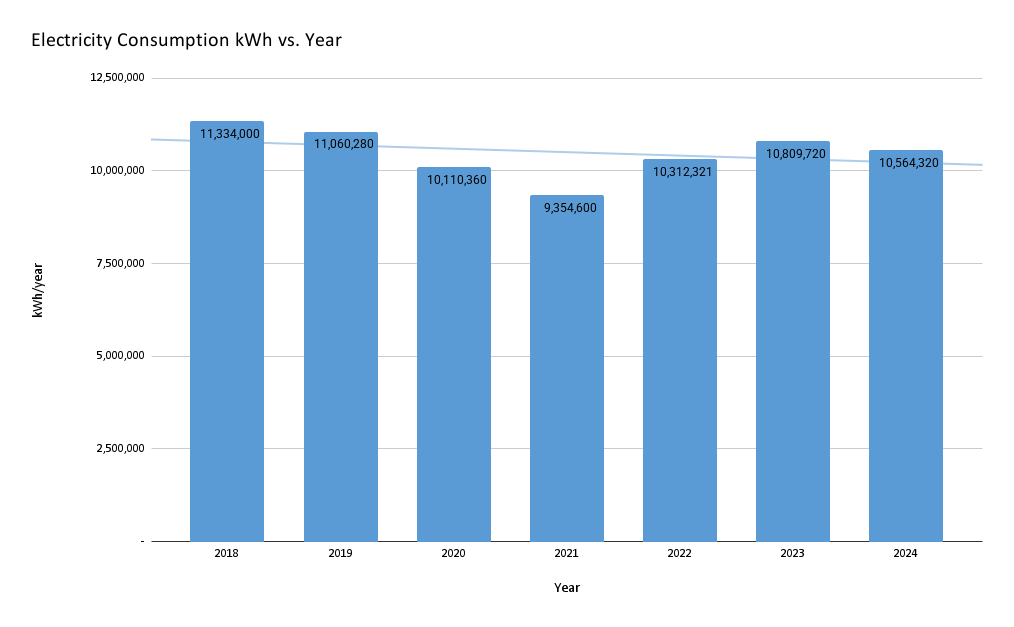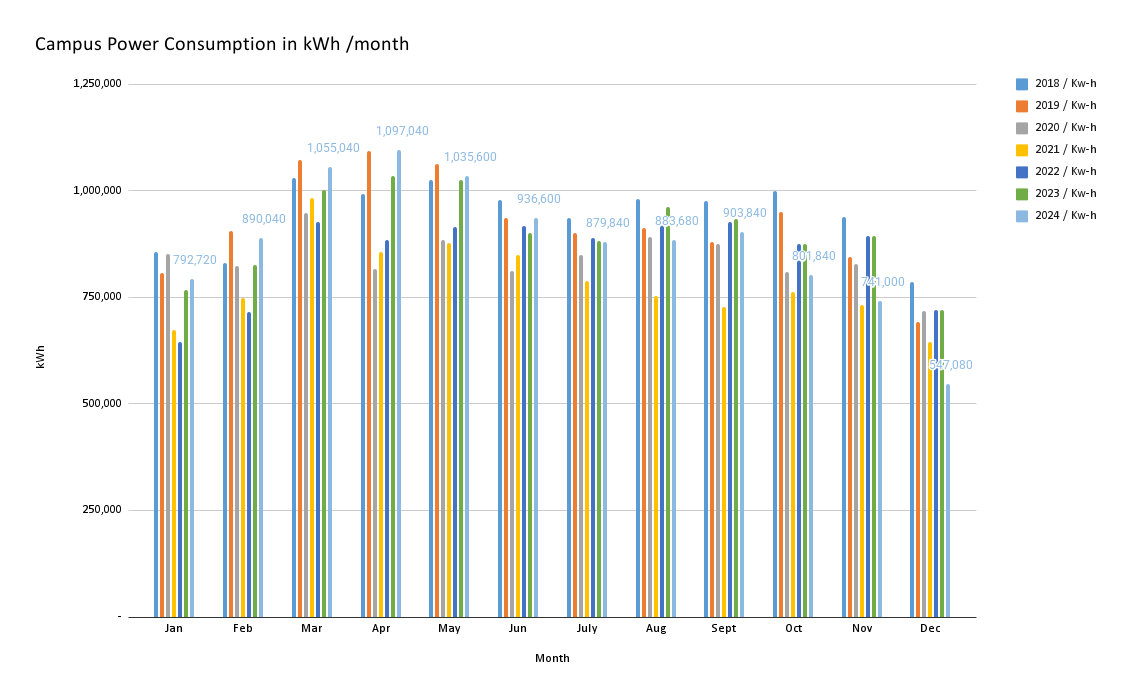AIT Commitment for Energy Conservation
The Asian Institute of Technology is dedicated to transforming into a “Botanical Garden Net Zero Campus by 2030.” In pursuit of this ambitious goal, AIT has established precise policy guidelines for ENERGY CONSERVATION. These guidelines place a premium on the promotion of energy-efficient architecture and the conscientious use of resources to optimize benefits while upholding environmental integrity. Furthermore, the institute emphasizes the integration of green spaces in and around each building, striving to reduce greenhouse gas emissions and transition to complete reliance on renewable energy sources. This approach also aims to enhance productivity by fostering the adoption of efficient building standards.
Energy Policy Statement:
The AIT is committed to reducing its greenhouse gas emissions by reducing its energy use and switching to clean and renewable energy supplies.
Energy Goals:
Goal 1: To reduce the (non-residential) AIT’s electricity use by 15% in 2026 compared to 2022
Electricity Consumption
The Provincial Electricity Authority (PEA) is responsible for providing electricity to the entire campus. Despite the challenges posed by the COVID-19 pandemic, the campus has managed to achieve a 10% decrease in electricity consumption compared to the pre-COVID year of 2018 and the post-COVID year of 2022, thanks to the implementation of various energy conservation measures.
In line with the goal of reducing AIT’s non-residential electricity usage by 15% in 2026, as part of its commitment to becoming a Botanical Garden NET ZERO Campus by 2030, AIT has launched a Solar rooftop project, aiming to generate 1.5 MW of power. This project is set to be completed by mid-2024. For more detailed information on AIT’s solar power initiatives, please click here
| Year | Power consumption from PEA in kWh | Percentge of Variance | Remarks | Power consumption to PEA Thai Baht | Percentge of Variance in kWh |
| 2018 | 11,334,000 | 41,816,443 | |||
| 2019 | 11,060,280 | -2.42% | 41,056,705 | -1.82% | |
| 2020 | 10,110,360 | -8.59% | Covid-19 | 37,115,298 | -9.60% |
| 2021 | 9,354,600 | -7.48% | Covid-19 | 34,353,343 | -7.44% |
| 2022 | 10,312,321 | 10.24% | Post Covid, normal opertaions | 43,609,056 | 26.94% |
| 2023 | 10,809,720 | 4.82% | 52,374,333 | 20.10% | |
| 2024 | 10,564,320 | -2.27% | 45,016,960 | -14.05% |
Low Carbon Energy Tracking / Solar Power on Campus
| Solar PV on campus | 2021 | 2022 | 2023 | 2024 |
| Library | 62,987.10 | 63,984.90 | 65,194.20 | 64,845.60 |
| Energy | 13,244.42 | 13,082.04 | 16,063.83 | 16,534.97 |
| Campus rooftop | 469,847.60 | |||
| Solar AFE | ||||
| Total kWh | 76,231.52 | 77,066.94 | 81,258.03 | 551,228.17 |


| Year/ unit | Jan | Feb | Mar | Apr | May | Jun | July | Aug | Sept | Oct | Nov | Dec | Annual |
| 2018 / Kw-h | 856,680 | 830,760 | 1,029,480 | 993,000 | 1,024,920 | 979,200 | 937,200 | 981,720 | 976,560 | 998,640 | 938,640 | 787,200 | 11,334,000 |
| 2019 / Kw-h | 808,320 | 905,040 | 1,073,400 | 1,092,480 | 1,062,480 | 935,160 | 902,040 | 913,920 | 879,600 | 950,280 | 845,760 | 691,800 | 11,060,280 |
| 2020 / Kw-h | 851,040 | 824,160 | 949,200 | 816,600 | 884,520 | 813,000 | 849,480 | 892,080 | 875,760 | 809,280 | 828,000 | 717,240 | 10,110,360 |
| 2021 / Kw-h | 672,480 | 747,480 | 983,040 | 856,560 | 878,160 | 849,600 | 789,480 | 753,600 | 727,920 | 763,320 | 731,640 | 646,320 | 9,354,600 |
| 2022 / Kw-h | 646,320 | 714,840 | 927,600 | 885,720 | 915,840 | 917,160 | 890,400 | 928,320 | 927,960 | 874,320 | 893,641 | 720,720 | 10,242,841 |
| 2023 / Kw-h | 767,760 | 825,360 | 1,002,480 | 1,034,040 | 1,025,760 | 901,680 | 881,520 | 961,560 | 933,240 | 874,320 | 893,641 | 720,720 | 10,822,081 |
| 2024 / Kw-h | 792,720 | 890,040 | 1,055,040 | 1,097,040 | 1,035,600 | 936,600 | 879,840 | 883,680 | 903,840 | 801,840 | 741,000 | 547,080 | 10,564,320 |
| Jan | Feb | Mar | Apr | May | Jun | July | Aug | Sept | Oct | Nov | Dec | Annual | |
| 2018 / Baht | 3,164,327 | 3,068,596 | 3,802,532 | 3,667,800 | 3,785,691 | 3,616,832 | 3,461,713 | 3,626,139 | 3,607,082 | 3,688,630 | 3,441,119 | 2,885,983 | 41,816,443 |
| 2019 / Baht | 3,000,594 | 3,359,592 | 3,984,498 | 4,055,317 | 3,943,966 | 3,471,389 | 3,348,457 | 3,392,552 | 3,265,166 | 3,527,510 | 3,139,561 | 2,568,104 | 41,056,705 |
| 2020 / Baht | 3,159,159 | 3,059,388 | 3,523,503 | 2,940,387 | 3,184,925 | 2,820,528 | 3,153,369 | 3,311,488 | 3,243,135 | 2,996,970 | 3,066,287 | 2,656,161 | 37,115,298 |
| 2021 / Baht | 2,304,390 | 2,745,020 | 3,609,977 | 3,145,553 | 3,148,428 | 3,119,996 | 2,899,241 | 2,767,492 | 2,673,197 | 2,803,183 | 2,686,857 | 2,373,569 | 34,353,343 |
| 2022 / Baht | 2,373,569 | 2,752,980 | 3,572,258 | 3,410,990 | 3,756,086 | 3,761,499 | 3,651,759 | 3,807,265 | 4,487,526 | 4,228,147 | 4,321,570 | 3,485,407 | 43,609,056 |
| 2023 / Baht | 4,218,014 | 4,534,439 | 5,507,445 | 5,680,819 | 4,935,527 | 4,338,836 | 4,241,835 | 4,626,953 | 4,248,038 | 3,721,832 | 3,372,941 | 2,947,655 | 52,374,333 |
| 2024 / Baht | 3,377,993 | 3,792,658 | 4,495,698 | 4,674,654 | 4,412,867 | 3,991,043 | 3,749,198 | 3,765,559 | 3,851,458 | 3,416,852 | 3,157,622 | 2,331,358 | 45,016,960 |